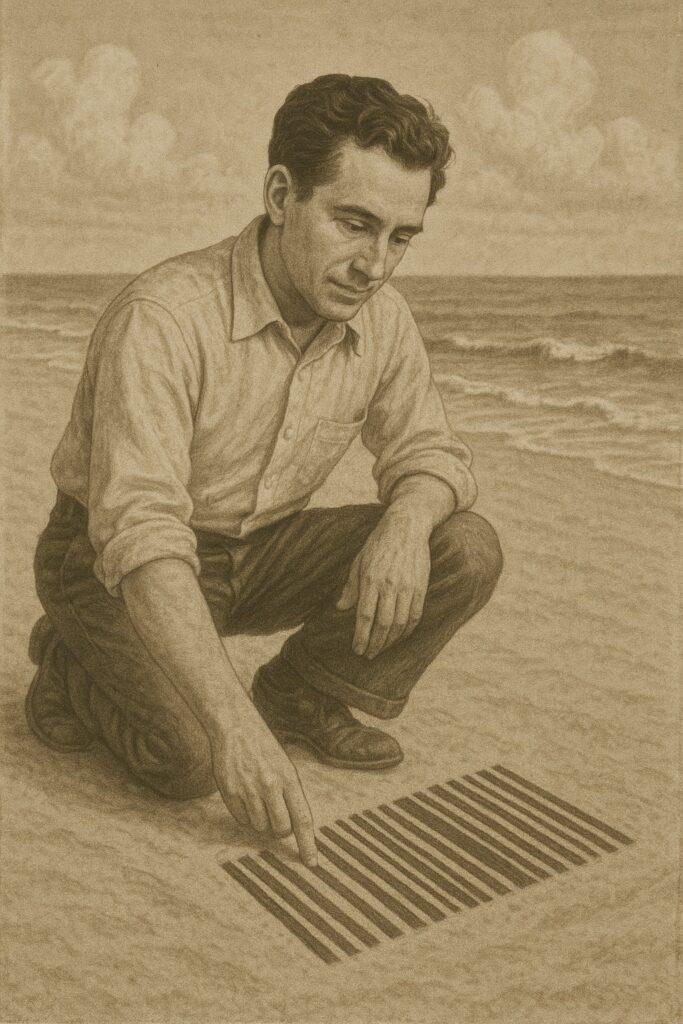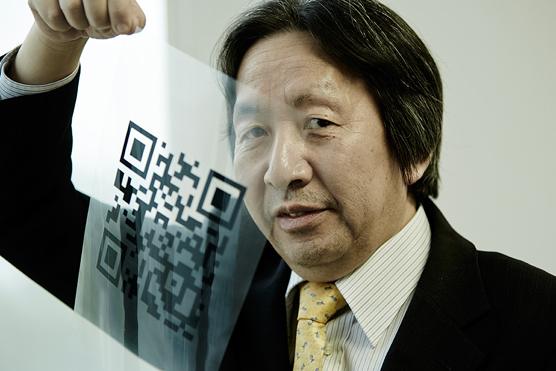[Reading level: C1 – Advanced]
Long before the first smartphone camera ever scanned a black-and-white square, a curious idea was born out of a question: what if humans could send messages without saying a word?
In the early 1830s, a man named Samuel Morse was tinkering with a problem. How could people communicate across great distances, faster than mail and more reliable than word of mouth? Alongside his partner Alfred Vail, Morse developed a system of dots and dashes—Morse code—to represent letters and numbers. When strung together, those sounds became messages that raced down telegraph wires. For the first time in human history, a thought could travel faster than a horse or ship. It wasn’t flashy, but it was revolutionary. Morse’s simple system sparked something even bigger: the idea that information could be encoded, broken down and sent through machines.
Nearly a century later, in 1948, that same idea echoed in the mind of a young graduate student named Norman Joseph Woodland. One afternoon, sitting on a beach in Florida, Woodland remembered Morse code. As he dragged his fingers through the sand, he transformed dots and dashes into long, thin lines—widening them into what we would now call “bars.” These lines, he realized, could represent data. And if a machine could read those lines with light, the possibilities were endless.

Along with his colleague Bernard Silver, Woodland filed a patent for this new invention: a way to automatically identify products using patterns of black bars and white spaces. It was the bar code, and though it would take years before it found a home in grocery stores, it would eventually change the way the world bought and sold goods. In 1974, in an Ohio supermarket, a pack of Wrigley’s gum became the first product scanned with a bar code. It was a quiet moment—but one that marked the beginning of the automated retail era.
Still, as the world grew more complex, so did its needs. By the early 1990s, on the busy floors of Toyota’s assembly lines, another problem was brewing. Workers had to track thousands of car parts with speed and accuracy, but bar codes were too slow. They held too little data and had to be scanned from a very specific angle. Frustrated with the inefficiency, an engineer named Masahiro Hara began searching for a better way.
Hara didn’t start from scratch. He looked at the bar code and wondered: what if information could be stored not in a line, but in a square—in two dimensions instead of one? What if it could be scanned from any direction, instantly?
With that idea, Hara and his team at Denso Wave created something new: the QR code—short for Quick Response. It was fast, easy to scan, and capable of holding hundreds of times more information than a bar code. At first, it was used quietly inside Toyota’s factories. But Hara and Denso Wave made one bold move: they decided not to patent it. That one decision flung the doors wide open.

Soon, QR codes leapt beyond factories. In advertisements. On packages. In bus stops and movie posters. And then came the smartphone—a camera in every pocket. Now, anyone could scan a QR code and be taken instantly to a website, a payment screen, a boarding pass, or a digital menu.
When the COVID-19 pandemic hit, and people needed contactless solutions, the QR code came into its own. No touching. No typing. Just scan and go. It had taken nearly two centuries, but that little square—descended from dots and dashes—had become a quiet hero of the digital age.
So the next time you scan a QR code, think of the beach in Florida where a young man drew lines in the sand, or the telegraph wire clicking out dots and dashes across the ocean. Think of a car factory in Japan, where speed and precision gave birth to a square that connects our physical world to the digital one.
The QR code didn’t just appear—it evolved, step by step, from one curious mind to another. It’s not just a square; it’s a symbol of how far a simple idea can travel.
WORD BANK:
out of sth /aʊt əv/ (prep): từ, vì cái gì
tinker with sth /ˈtɪŋ.kɚ/ (v): mày mò, nghịch, chỉnh sửa cái gì
dot /dɑːt/ (n): chấm
dash /dæʃ/ (n): gạch ngang
string sth together /strɪŋ/ (v): kết nối, nối lại với nhau
telegraph wire /ˈtel.ə.ɡræf ˌwaɪr/ (n): dây điện tín
flashy /ˈflæʃ.i/ (adj): hào nhoáng
revolutionary /ˌrev.əˈluː.ʃə.ner.i/ [B2] (adj): cách mạng
spark sth /spɑːrk/ (v): khơi dậy cái gì
encode /ɪnˈkoʊd/ [C1] (v): mã hóa
echo /ˈek.oʊ/ [B2] (v): vang vọng
drag sth /dræɡ/ [B2] (v): kéo
represent sth /ˌrep.rɪˈzent/ [B2] (v): đại diện cho cái gì
possibility /ˌpɑː.səˈbɪl.ə.t̬i/ [B1] (n): khả năng
file a patent /faɪl ə ˈpæt.ənt/ (v): nộp đơn xin cấp bằng sáng chế
pattern /ˈpæt̬.ɚn/ [B1] (n): mẫu, mô hình
eventually /ɪˈven.tʃu.ə.li/ [B2] (adv): cuối cùng
retail /ˈriː.teɪl/ [B2] (n): bán lẻ
assembly line /əˈsem.bli ˌlaɪn/ (n): dây chuyền sản xuất
angle /ˈæŋ.ɡəl/ [B2] (n): góc
frustrated /ˈfrʌs.treɪ.t̬ɪd/ [B2] (adj): thất vọng
inefficiency /ˌɪn.ɪˈfɪʃ.ən.si/ (n): sự kém hiệu quả
do sth from scratch /frʌm skrætʃ/ (v): làm gì từ con số không
dimension /ˌdaɪˈmen.ʃən/ [C1] (n): chiều, hướng, khía cạnh
instantly /ˈɪn.stənt.li/ [B2] (adv): ngay lập tức
make a bold move /boʊld muːv/ (v): đưa ra một quyết định táo bạo
fling the door wide open /flɪŋ/ (v): mở toang cánh cửa
leap /liːp/ [C1] (v): nhảy vọt
beyond sth /biˈjɑːnd/ [B2] (prep): vượt ra ngoài cái gì
boarding pass /ˈbɔːr.dɪŋ ˌpæs/ (n): thẻ lên tàu bay
contactless /ˈkɑːn.tækt.ləs/ (adj): không tiếp xúc
come into one’s own /kʌm ˈɪn.tu wʌnz oʊn/ (idiom): trở nên vô cùng hữu dụng
descended from sth /dɪˈsen.dɪd frəm/ (v): ra đời từ cái gì, có nguồn gốc từ
click /klɪk/ (v): kêu tích tắc
precision /prəˈsɪʒ.ən/ [C1] (n): độ chính xác
evolve /ɪˈvɑːlv/ [B2] (v): tiến hóa
ỦNG HỘ READ TO LEAD!
Chào bạn! Có thể bạn chưa biết, Read to Lead là một trang giáo dục phi lợi nhuận với mục đích góp phần phát triển cộng đồng người học tiếng Anh tại Việt Nam. Chúng tôi không yêu cầu người đọc phải trả bất kỳ chi phí nào để sử dụng các sản phẩm của mình để mọi người đều có cơ hội học tập tốt hơn. Tuy nhiên, nếu bạn có thể, chúng tôi mong nhận được sự hỗ trợ tài chính từ bạn để duy trì hoạt động của trang và phát triển các sản phẩm mới.
Bạn có thể ủng hộ chúng tôi qua 1 trong 2 cách dưới đây.
– Cách 1: Chuyển tiền qua tài khoản Momo.
Số điện thoại 0947.886.865 (Chủ tài khoản: Nguyễn Tiến Trung)
Nội dung chuyển tiền: Ủng hộ Read to Lead
hoặc
– Cách 2: Chuyển tiền qua tài khoản ngân hàng.
Ngân hàng VIB chi nhánh Hải Phòng
Số tài khoản: 012704060048394 (Chủ tài khoản: Nguyễn Tiến Trung)
Nội dung chuyển tiền: Ủng hộ Read to Lead
Lớp luyện thi IELTS online
Bạn đang có nhu cầu thi chứng chỉ IELTS cho đầu vào đại học, đi du học, xin việc hay xin cư trú và đang phân vân chưa biết học ở đâu?
Nếu bạn đang tìm kiếm dịch vụ luyện thi IELTS online với giáo viên uy tín và chất lượng, cũng như học phí phải chăng, thì thầy Trung và Cô Thủy (Admin và dịch giả chính của Read to Lead) có thể là một lựa chọn phù hợp dành cho bạn.
Hãy liên hệ (nhắn tin) tới trang Facebook cá nhân của mình (https://www.facebook.com/nguyen.trung.509) để tìm hiểu về lớp học và được tư vấn cũng như được học thử nha!





